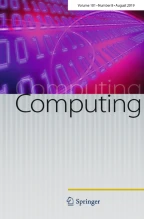Abstract
In this paper, the performance of Binary Increase Adaptive Decrease (TCP-BIAD) congestion control algorithm in high-speed long-distance networks is evaluated. As its name implies, this TCP variant is a combination of an enhanced binary increase algorithm during the congestion avoidance phase with the adaptive decrease mechanism of TCP Westwood after a packet loss episode. We also propose a mathematical analysis of the TCP-BIAD paradigm to study the steady-state throughput provided by TCP-BIAD and investigate the intra-protocol friendliness between TCP-BIAD and Additive Increase/Multiplicative Decrease algorithms. Our analysis shows that TCP-BIAD algorithm is exponentially stable, while maintaining an adequately fair and friendly behavior with respect to co-existing TCP-Reno flows. Finally, our results are validated with respect to other TCP variants such as BIC-TCP, CUBIC, HighSpeed TCP, HTCP, Hybla and TCP-Reno by means of computer simulations in networks with large bandwidth-delay products and low sensitivity to RTT values.
Similar content being viewed by others
Explore related subjects
Discover the latest articles, news and stories from top researchers in related subjects.Notes
The minimum window \((W_{min})\) is defined as the speed at which no packet loss occurs and the maximum window \((W_{max})\) is the cwnd value for which packet loss occurs.
TCP-BIAD implementation is available at http://wesis.teiemt.gr/projects/a-linux-tcp-implementation-of-tcp-biad-for-ns2/.
References
Arokkiam JA, Wu X, Brown KN, Sreenan CJ (2014) Experimental evaluation of TCP performance over 10 Gb/s passive optical networks (XG-PON). In: 2014 IEEE global communications conference, pp 2223–2228
Floyd S (2003) HighSpeed TCP for large congestion windows. Technical report RFC3649, RFC editor, December
Floyd S, Jacobson V (1993) Random early detection gateways for congestion avoidance. IEEE/ACM Trans Netw 1(4):397–413
Grieco LA, Mascolo S (2003) End-to-end bandwidth estimation for congestion control in packet networks. In: Proceedings of the second international workshop on quality of service in multiservice IP networks, QoS-IP 2003, London, UK. Springer, pp 645–658
Ha S, Rhee I, Xu L (2008) CUBIC: a new TCP-friendly high-speed TCP variant. ACM SIGOPS Oper Syst Rev 42(5):64–74
Kelly F (2001) Mathematical modelling of the internet. In: Engquist B, Schmid W (eds)Mathematics unlimited 2001 and beyond. Springer, Berlin, Heidelberg, pp 685–702
Kelly T (2003) Scalable TCP: improving performance in highspeed wide area networks. ACM SIGCOMM Comput Commun Rev 33(2):83
Kliazovich D, Granelli F, Miorandi D (2008) Logarithmic window increase for TCP Westwood+ for improvement in high speed, long distance networks. Comput Netw 52(12):2395–2410
Leith D, Shorten R, Li Y (2005) H-TCP: a framework for congestion control in high-speed and long-distance networks. HI technical report
Paxson V, Floyd S (1995) Wide area traffic: the failure of Poisson modeling. IEEE/ACM Trans Netw 3(3):226–244
Peterson LL, Davie BS (2012) Computer networks: a systems approach. TheMorgan Kaufmann series in networking, 5th edn. Morgan Kaufmann, Amsterdam
Tsiknas K, Stamatelos G (2014) TCP-BIAD for enhancing TCP performance in broadband wireless access networks. Wirel Pers Commun 78(1):785–799
Tsiknas KG, Schinas CJ, Stamatelos G (2014) Binary increase-adaptive decrease (BIAD): a variant for improving TCP performance in broadband wireless access networks. IEICE Trans Commun E97.B(8):1606–1613
Wei DX, Jin C, Low SH, Hegde S (2006) FAST TCP: motivation, architecture, algorithms, performance. IEEE/ACM Trans Netw 14(6):1246–1259
Xu L, Harfoush K, Rhee I (2004) Binary increase congestion control (BIC) for fast long-distance networks. In: IEEE INFOCOM 2004, vol 4. IEEE, Hong Kong, China, pp 2514–2524
Author information
Authors and Affiliations
Corresponding author
Rights and permissions
About this article
Cite this article
Tsiknas, K., Rantos, K., Schinas, C.J. et al. Performance evaluation of TCP-BIAD in high-speed, long-distance networks. Computing 101, 319–337 (2019). https://doi.org/10.1007/s00607-018-0673-y
Received:
Accepted:
Published:
Issue Date:
DOI: https://doi.org/10.1007/s00607-018-0673-y
